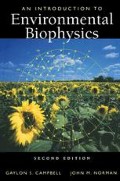Abstract
In Ch. 14 plant canopies are treated as big leaves. We did not worry about their structure or the details of how the leaves make up the canopy, we just assumed that we could find a canopy conductance for vapor and boundary layer conductances for heat and vapor. Combining these with the absorbed radiation and soil heat flux densities allowed us to compute canopy temperatures and transpiration rates. We even estimated carbon assimilation rates by knowing transpiration rate or light interception.
Access this chapter
Tax calculation will be finalised at checkout
Purchases are for personal use only
Preview
Unable to display preview. Download preview PDF.
References
Anderson, M. C., J.M. Norman, G.R. Diak, W.P. Kustas, and J.R. Mecikalski (1997) A two-source time-integrated model for estimating surface fluxes using thermal infrared remote sensing. Remote Sensing of Environment 60:195–216.
Campbell, G. S. (1986) Extinction coefficients for radiation in plant canopies calculated using an ellipsoidal inclination angle distribution. Agricultural and Forest Meteorology 36:317–321.
Campbell, G.S. (1990) Derivation of an angle density function for canopies with ellipsoidal leaf angle distributions. Agricultural and Forest Meteorology 49:173–176
Campbell, G. S. and F. K. van Evert (1994) Light interception by plant canopies: efficiency and architecture. In J. L. Monteith, R. K. Scott, and M. H. Unsworth, Resource Capture by Crops. Nottingham University Press.
Carlson, T,N., W.J. Capehart, and R.R. Gillies (1995) A new look at the simplified method for remote sensing of daily evapotranspiration. Remote Sensing of Environment 54:161–167.
Chen, J.M. 1996. Optically-based methods for measuring seasonal variation of leaf area index in boreal conifer stands. Agricultural and Forest Meteorology 80:135–163.
Fassnacht, K.S., S.T. Gower, J.M. Norman, and R.E. McMurtrie (1994) A comparison of optical and direct methods for estimating foliage surface area index in forests. Agricultural and Forest Meteorology 71:183–207.
Fuchs. M., G. Stanhill, and S. Moreshet (1976) Effect of increasing foliage and soil reflectivity on the solar radiation balance of wide-row sorghum. Agronomy Journal 68:865–871.
Goudriaan, J. (1977) Crop micrometeorology: a simulation study. Simulation Monographs, Pudoc, Wageningen.
Goudriaan, J. (1988) The bare bones of leaf-angle distribution in radiation models for canopy photosynthesis and energy exchange. Agricultural and Forest Meteorology 43:155–169.
Irons, J., G.S. Campbell, J.M. Norman, D.W. Graham, and W.K. Kovalick (1992) Prediction and measurement of soil bidirectional reflectance. IEEE Transactions of Geoscience and Remote Sensing. 30:249–260.
Kuusk, A. (1991) The hot spot effect in plant canopy reflectance. In Photon-Vegetation Interactions: Applications in Optical Remote Sensing and Plant Ecology. Eds. R.B. Myneni and J. Ross. Springer-Verlag, Berlin. pp. 139–159.
Kuusk, A. (1995) A fast, invertible canopy reflectance model. Remote Sensing of Environment. 51:342–350.
Monteith, J.L. and M.H. Unsworth. (1990) Principles of Environmental Physics. Edward Arnold Publishers, London. 291 pp.
Myneni, R.B. and J. Ross. (eds.) (1991) Photon-Vegetation Interactions: Applications in Optical Remote Sensing and Plant Ecology. Springer-Verlag, Berlin. 565 pp.
Norman, J.M. (1992) Scaling processes between leaf and canopy levels. In Scaling Physiological Processes: Leaf to Globe. Eds. J.R. Ehleringer and C.B. Field. Academic Press, Inc. San Diego, CA pp. 41–76.
Norman, J.M. and G.S. Campbell (1989) Canopy structure. In Plant Physiological Ecology: Field Methods and Instrumentation. Eds. R.W. Pearcy, J. Ehleringer, H.A. Mooney, and P.W. Rundel. Chapman and Hall, N.Y. pp. 301–325.
Norman, J.M. and J.M. Welles (1983) Radiative transfer in an array of canopies. Agronomy Journal 75:481–488.
Walthall, C.L., J.M. Norman, J.M. Welles, G.S. Campbell, and B.L. Blad (1985) Simple equation to approximate the bidirectional reflectance from vegetative canopies and bare soil surfaces. Applied Optics. 24:383–387.
Welles, J.M. (1990) Some indirect methods for determining canopy structure. Remote Sensing Reviews. 5:31–43.
Author information
Authors and Affiliations
Rights and permissions
Copyright information
© 1998 Springer Science+Business Media New York
About this chapter
Cite this chapter
Campbell, G.S., Norman, J.M. (1998). The Light Environment of Plant Canopies. In: An Introduction to Environmental Biophysics. Springer, New York, NY. https://doi.org/10.1007/978-1-4612-1626-1_15
Download citation
DOI: https://doi.org/10.1007/978-1-4612-1626-1_15
Publisher Name: Springer, New York, NY
Print ISBN: 978-0-387-94937-6
Online ISBN: 978-1-4612-1626-1
eBook Packages: Springer Book Archive

